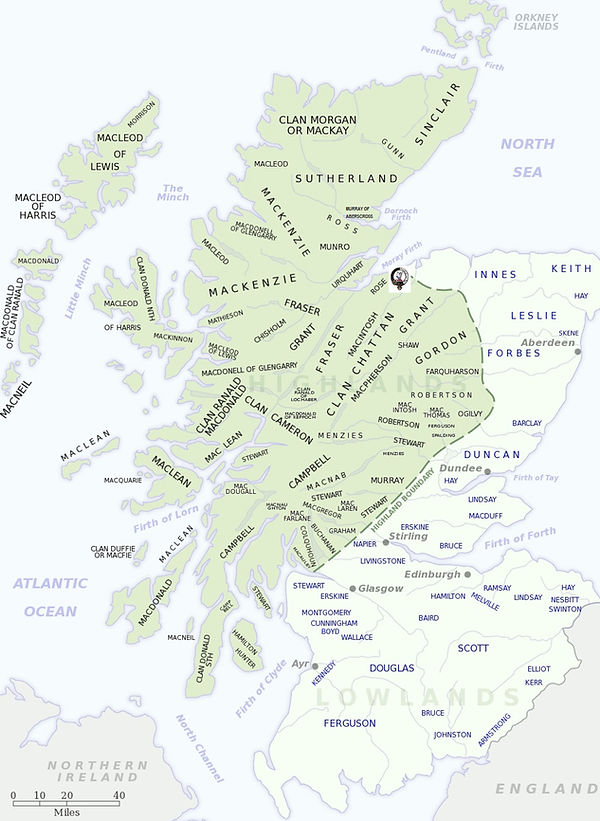

The Rose Family Line in Scotland
Numerous records indicate that the family de Ros/ Rose appeared in Nairn during the reign of David I, and are of Anglo-Norman origin (See Norman origins of Clan Rose). Although not yet definitively determined, researchers indicate that a man descended from the de Ros family of Helmsley, possibly through the barony of Wark, and settled in Geddes during the 1200s. The lands of Kilravock were acquired later through the marriage of Hugh de Ros of Geddes to Marie de Bosco. Marie de Bosco’s mother was an heiress of the Bisset Family and father was Sir Andrew de Bosco of Redcastle. The ties between the de Bosco, de Bisset, and the de Ros families appear to have gone back to earlier times in Normandy.
During the Scottish Wars of Independence, Norman Baron Robert de Ros, Lord of Wark in Northumberland, due to his love of a young Scottish lady and disdain for Edward I, sided with the Scottish cause for independence.
“On 25 September 1298 Robert de Ros of Wark was forfeited by Edward I, King of England, probably because he joined William Wallace and took part with him in the Battle of Stirling Bridge.” [Source: Geoffrey W. S. Barrow, Robert Bruce and the Community of the Realm of Scotland, page. 102]
Domestically, from acquisition of the property in the 1200's through to 1460 the de Ros / Rose Clan Chief lived in a stone fortified house up the hill from the later ancestral home we know as Kilravock Castle.
Of historic note during this pre-castle period is the marriage of Hugh, 4th of Kilravock to Janet Chisholm, the daughter of Sir Robert Chisholm, Constable of Urquhart Castle. It is from this union that Hugh gained lands in Strathnairn and later generations of the Kilravock line would adopt the Red (gules) Chisholm boars head as a heraldic device incorporated into the arms of Kilravock.
It has been said that all of the earliest family records were lost in this pre-castle period during the destruction of Elgin Cathedral, where the documents had been placed for safekeeping. This happened in 1390 when Robert II's renegade brother Alexander Stewart, also known as the “Wolf of Badenoch” laid siege to the Cathedral. Afterwards, the family had to obtain replacement Charters from James I, the Earls of Ross and the Chisholm.
The ancestral home best recognized by Clan Rose, Kilravock Castle, was built in 1460 by the 7th Laird, Hugh Rose. Despite the turbulence of the following century, the Clan remained mostly peaceable, with the castle only being taken once for a very brief time and quickly reacquired. Kilravock has remained an important part of Clan Rose heritage and identity from the 1460s to the present day. Kilravock and our Clan have been players in both Scottish and world history.
One well known account is that Mary Queen of Scots visited Kilravock overnight on her way to Inverness in 1562. She is known to have corresponded with the 10th Laird several times. Mary's son, James VI, also visited Kilravock in 1598, treating the 10th Laird like close family.
In the reign of Charles I, the 13th Laird was a supporter of the National Covenant and in 1643 lead the Clan against the Marquis of Montrose at the Battle of Auldearn. Around this time, Alexander Rose (1647-1720) was born in Aberdeenshire. He became Bishop of Moray in 1687 and Bishop of Edinburgh in 1688. Although he represented the Scottish Bishops when William of Orange arrived in London, he refused to give up his allegiance to James VII.
During the 1715 Jacobite Uprising, Arthur Rose a brave brother of the 15th Laird, was killed while fighting with the government forces. In 1746, both the Clan and ancestral home were in jeopardy. On the eve of the Battle of Culloden, Hugh, 16th Laird, despite favoring the government cause, cordially entertained Prince Charles Edward Stuart at Kilravock Castle, while the Duke of Cumberland was installed nearby at the Rose's town house in Nairn. While the Kilravock estate is not often cited as a factor in the battle, some historians point out that Charles Stuart's forces found great difficulty navigating through the forested terrain of Kilravock. Shortly after Bonnie Prince Charlie's visit, his cousin and advisory, the Duke of Cumberland, also paid a visit to the 16th Laird. Knowing that the old Laird had no substantial force to resist an army on his doorstep he found no fault in Kilravock the 16th's Highland Hospitality to his cousin.
Other well-known members of the family include George Rose (1744-1818) who entered politics and became a staunch supporter of the British Prime Minister, William Pitt. One of the most prominent soldier-politicians of the Victorian era was Field Marshall Sir Hugh Rose (1801-1885) who served Great Britian's interest in India and was Baron of Strathnairn.
In the 20th century; the Clan suffered a true tragedy when Lieutenant Colonel Hugh Rose, son and heir-apparent of the 24th Laird, met his death at the second battle of El Alamein in 1946, while serving in the Black Watch Regiment. With his passing, the Chiefship passed to his sister, Anna Elizabeth Guillemard Rose, the 25th of Kilravock.
Our current Clan Chief is David Hugh Heriot Baird Rose, the 26th Baron of Kilravock.
See Council page for more info on our Clan Chief.
